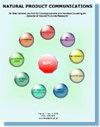Phytochemical Content, In Vitro Antioxidant, and Cholinesterase Inhibitory Activities Determination of Endemic Linaria corifolia Desf
IF 1.4
4区 医学
Q4 CHEMISTRY, MEDICINAL
引用次数: 0
Abstract
Objective: In our study, we researched the chemical composition of Linaria corifolia Desf. We also tested in vitro antioxidant, and anticholinesterase activities of different extracts, and compounds from L. corifolia. Methods: We isolated from ethyl acetate and n-butanol extracts of L. corifolia aerial parts. We used various spectroscopic methods. We also compared the results with data in the literature. This allowed us to determine the structure of the compounds. We used different spectroscopic methods and comparisons with literature data to determine the structure of the compounds. We evaluated the antioxidant activities of 20% aqueous methanol, ethyl acetate, and n-butanol extracts using DPPH, ABTS Radical Scavenging Effect, and CUPRAC Assay, and also examined total phenol and flavonoid contents. We used Ellman's method to find the cholinesterase inhibitor activities of the extracts, and isolated compounds. Results: We isolated 6 compounds in ethyl acetate and n-butanol extracts. These compounds have terpenoid (iridoid glycosides), and phenolics (flavonoid, and phenylpropanoid structures). We isolated linariin and acteoside (verbascoside) from ethyl acetate. We isolated antirrhinoside, 6-ß-Hydroxyantirrhide, catalpol, and aucubin from n-butanol extract. The ethyl acetate extract was most active in all antioxidant methods due to its high phenolic content. In contrast to phenolic content, n-butanol extract had more flavonoids. The ethyl acetate extract had higher acetylcholinesterase inhibitory activity at 200 and 400 μg/ml. Linariin had the highest acetylcholinesterase inhibitory effect among the pure compounds. The extracts and pure compounds inhibited butyrylcholinesterase less than acetylcholinesterase. Conclusion: The isolated compounds are new compounds for the L. corifolia plant. The plant's cholinesterase inhibitor activity was investigated for the first time. We found low anti-acetylcholinesterase and butyrylcholinesterase activities.地方性亚麻属植物的植物化学成分含量、体外抗氧化剂和胆碱酯酶抑制活性测定
研究目的在本研究中,我们研究了日本矢车菊(Linaria corifolia Desf)的化学成分,并测试了不同提取物和化合物的体外抗氧化和抗胆碱酯酶活性。我们还测试了不同提取物和化合物的体外抗氧化和抗胆碱酯酶活性。方法:我们从 L. corifolia 气生部分的乙酸乙酯和正丁醇提取物中进行了分离。我们使用了多种光谱方法。我们还将结果与文献数据进行了比较。这使我们能够确定化合物的结构。我们使用了不同的光谱方法,并与文献数据进行了比较,从而确定了化合物的结构。我们使用 DPPH、ABTS 自由基清除效果和 CUPRAC 分析法评估了 20% 水甲醇、乙酸乙酯和正丁醇提取物的抗氧化活性,还检测了总酚和类黄酮的含量。我们采用埃尔曼法检测了提取物和分离化合物的胆碱酯酶抑制活性。结果我们从乙酸乙酯和正丁醇提取物中分离出了 6 种化合物。这些化合物具有萜类(鸢尾甙)和酚类(黄酮类和苯丙类)结构。我们从乙酸乙酯中分离出了利奈瑞林和猕猴桃苷(马鞭草苷)。我们从正丁醇提取物中分离出了抗血清甙、6-ß-羟基抗血清甙、梓醇和杜鹃甙。乙酸乙酯提取物由于酚含量高,在所有抗氧化方法中活性最强。与酚含量相比,正丁醇提取物中的黄酮类化合物含量更高。乙酸乙酯提取物在 200 和 400 μg/ml 的乙酰胆碱酯酶抑制活性较高。在纯化合物中,亚麻仁素对乙酰胆碱酯酶的抑制作用最强。提取物和纯化合物对丁酰胆硷酯酶的抑制作用低于对乙酰胆碱酯酶的抑制作用。结论分离出的化合物是 L. corifolia 植物的新化合物。我们首次研究了该植物的胆碱酯酶抑制剂活性。我们发现其抗乙酰胆碱酯酶和丁酰胆碱酯酶的活性较低。
本文章由计算机程序翻译,如有差异,请以英文原文为准。
求助全文
约1分钟内获得全文
求助全文
来源期刊

Natural Product Communications
工程技术-食品科技
CiteScore
3.10
自引率
11.10%
发文量
254
审稿时长
2.7 months
期刊介绍:
Natural Product Communications is a peer reviewed, open access journal studying all aspects of natural products, including isolation, characterization, spectroscopic properties, biological activities, synthesis, structure-activity, biotransformation, biosynthesis, tissue culture and fermentation. It covers the full breadth of chemistry, biochemistry, biotechnology, pharmacology, and chemical ecology of natural products.
Natural Product Communications is a peer reviewed, open access journal studying all aspects of natural products, including isolation, characterization, spectroscopic properties, biological activities, synthesis, structure-activity, biotransformation, biosynthesis, tissue culture and fermentation. It covers the full breadth of chemistry, biochemistry, biotechnology, pharmacology, and chemical ecology of natural products.
Natural Product Communications is a peer reviewed, open access journal studying all aspects of natural products, including isolation, characterization, spectroscopic properties, biological activities, synthesis, structure-activity, biotransformation, biosynthesis, tissue culture and fermentation. It covers the full breadth of chemistry, biochemistry, biotechnology, pharmacology, and chemical ecology of natural products.
 求助内容:
求助内容: 应助结果提醒方式:
应助结果提醒方式:


